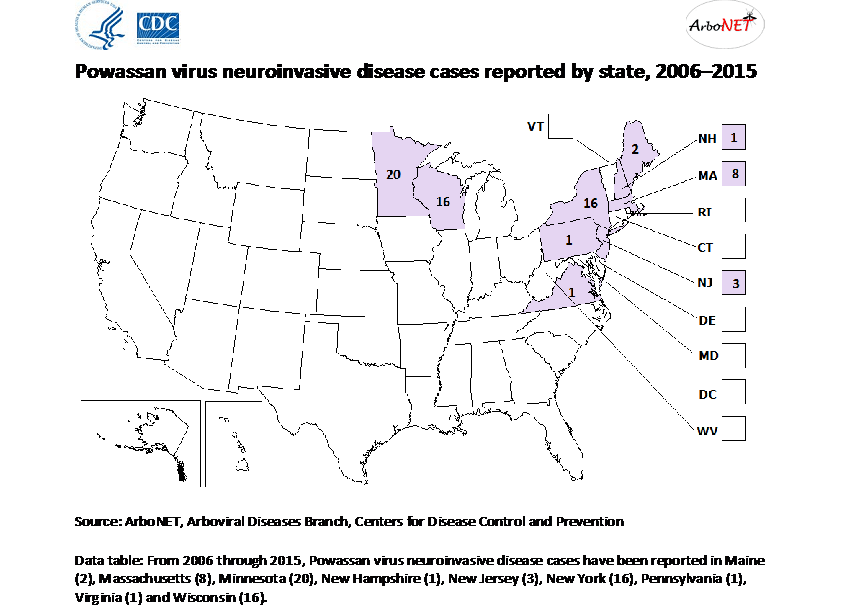
Just in time for summer, cases of a rare tick-borne illness appear to be increasing. While Lyme disease has been on the radar for years and is far more common, the potentially life-threatening Powassan virus (POW) is an even more ominous infection. Some scientists believe that, as a result of warmer winters, tick populations are thriving. While POW virus is rare, it is becoming more prevalent in deer ticks, sometimes called black-legged ticks, which can infect a number of mammals, including humans as "accidental" hosts.
According to the Centers for Disease Control and Prevention (CDC), "Powassan virus is transmitted to humans by the bite of an infected tick. Approximately 75 cases of POW virus disease were reported in the United States over the past ten years, with most cases occurring in the Northeast and Great Lakes regions." Most infections take place during the late spring, early summer, and mid-fall when ticks are most active. Powassan virus cannot be transmitted from person-to-person.

Powassan virus neuroinvasive disease cases reported by state, 2006-2015
- Maine - 2
- Massachusetts - 8
- Minnesota - 20
- New Hampshire - 1
- New Jersey - 3
- New York - 16
- Pennsylvania - 1
- Virginia - 1
- Wisconsin - 16
Symptoms
Most people who become infected with POW virus do not develop any symptoms. Those who do become sick usually develop symptoms within one week to one month from the time the tick bites them. Symptoms may include:
- Fever
- Headache
- Vomiting
- Weakness
- Confusion or Memory Loss
- Loss of coordination
- Speech difficulties
- Seizures
Of particular concern, according to the CDC is that about 10% of POW infections are fatal and other victims may suffer from severe, lifelong neurological conditions as a result of encephalitis (inflammation of the brain) or meningitis (inflammation of the membranes that surround the brain and spinal cord).
Diagnosis and Treatment
If Powassan virus or another tick-borne illness is suspected based on the presenting symptoms, laboratory testing of the blood or spinal fluid will confirm the diagnosis. These tests detect antibodies that the immune system makes against the viral infection. There is no specific treatment for POW, but people with a severe case of the virus often need to be hospitalized to receive respiratory support, intravenous fluids, or medications to reduce swelling in the brain.
Prevention
Since there is no vaccine for Powassan virus disease, the most effective method of preventing it is to protect against tick bites in general. Methods of prevention include:
- Avoid tick habitats to reduce your chances of being bitten:
- Avoid moist, shaded, wooded, or brushy areas.
- When walking in the outdoors, stay on cleared, well-traveled paths, and walk in the center of trails to avoid overgrown grass and brush.
- Avoid sitting on the ground or on stone walls.
- Remove leaves, brush, and woodpiles from around your home and the yard.
- Mow the grass often.
- Discourage animals that carry ticks from coming onto your property.
- Proper clothing can help protect you from tick bites. When spending time outdoors in areas where there may be ticks, you should:
- Wear long pants and a long-sleeved shirt of a light color. Light-colored clothing makes it easier to see ticks.
- Tuck shirt into pants and pants into socks. Wear a hat and closed shoes. This makes it more difficult for ticks to get onto your skin.
- Put your clothes in the dryer on high heat for about 20 minutes after spending time outdoors to kill any unseen ticks.
- Apply insect repellent that contains 20 percent or more DEET, picaridin, or IR3535 on exposed skin and clothing for protection that lasts several hours. Be sure to follow manufacturer directions carefully. Parents should apply the product to their children, avoiding hands, eyes, and mouth. Insect repellents containing permethrin also can be applied to pants, socks, shoes, and camping gear, and remains protective through several washings. The Environmental Protection Agency (EPA) has a website to help determine the insect repellent that is right for you or your family.
- Find and remove ticks immediately before they have a chance to bite and attach.
- Do frequent tick checks, including a naked, full body exam when returning from the outdoors. Parents should thoroughly check children, especially in their hair. Remember that young ticks can be very small, not much bigger than a sesame seed.
- If you find any ticks, do the following:
- With fine-point tweezers, grab the tick where it is attached, next to the skin.
- Gently pull the tick straight out.
- Save the tick in a small vial and mark the date.
- Wash your hands and clean the tweezers with alcohol.
- Report the bite to your doctor.
- Bathe or shower within two hours after being outdoors to wash off or examine for ticks.
- Examine clothing, gear, and pets for ticks, as well.
Most importantly, if a tick bites you, or someone you know, please consult your healthcare provider immediately.